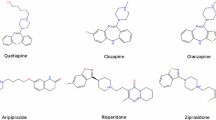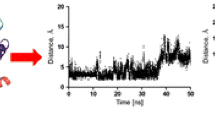Abstract
The activation mechanism of dopamine receptors is unknown. The amino acids S5.42, S5.43, and S5.46 located in helix 5 appear to be crucial, but their specific roles in receptor activation have not been studied. We modeled the D1 dopamine receptor using the crystal structures of the D3 dopamine and β2 adrenergic receptors. Molecular dynamics simulations show that the interaction of dopamine with the D1 receptor leads to the formation of a hydrogen-bond network with its catechol group and helices 3, 5, and 6, including water molecules. The para hydroxyl group of dopamine binds directly to S5.42 and N6.55, the latter also interacting with S5.43. Unexpectedly, S5.46 does not interact directly with the catechol; instead, it interacts through a water molecule with S5.42 and directly with T3.37. The formation of this hydrogen-bond network, part of which was previously observed in docking studies with dopamine agonists, triggers the opening of the E6.30–R3.60 ionic lock associated with the activation of GPCRs. These changes do not occur in the unbonded (apo) receptor or when it is in a complex with the antagonist 3-methoxy-5,6,7,8,9,14-hexahydrodibenz[d,g]azecine. Our results provide valuable insight into the T3.37–S5.46–water–S5.43–ligand interaction, which may be crucial to the activation of the D1 dopamine receptor and should be considered during the design of novel agonists.

General representation of the relationship between the formation of the HBN and the opening of the R3.50–E6.30 ionic lock






Similar content being viewed by others
References
Hardman JG, Goodman-Gilman A, Limbird LE (1995) Goodman & Gilman’s the pharmacological basis of therapeutics, 9th edn. McGraw-Hill, New York, pp. 283–282
Kalant H, Roschlau W (1998) Principles of medical pharmacology, 6th edn. Oxford University Press, Oxford, pp 101–104
Malo M, Brive L, Luthman K, Svensson P (2010) Selective pharmacophore models of dopamine D1 and D2 full agonists based on extended pharmacophore features. ChemMedChem 5:232–246
Malo M, Brive L, Luthman K, Svensson P (2012) Investigation of D1 receptor–agonist interactions and D1/D2 agonist selectivity using a combination of pharmacophore and receptor homology modeling. ChemMedChem 7:483–494
Ballesteros JA, Weinstein H (1995) In: Stuart CS (ed) Methods in neurosciences, vol 25. Academic, San Diego, pp 366–428
Platania CBM, Salomone S, Leggio GM, Drago F, Bucolo C (2012) Homology modeling of dopamine D2 and D3 receptors: molecular dynamics refinement and docking evaluation. PLoS One 7:e44316
Platania CBM, Leggio GM, Drago F, Salomone S, Bucolo C (2013) Regulation of intraocular pressure in mice: structural analysis of dopaminergic and serotonergic systems in response to cabergoline. Biochem Pharmacol 86:1347–1356
Ye N, Neumeyer JL, Baldessarini RJ, Zhen X, Zhang A (2013) Update 1 of: recent progress in development of dopamine receptor subtype-selective agents: potential therapeutics for neurological and psychiatric disorders. Chem Rev 113:R123–PR178
Chemel BR, Bonner LA, Watts VJ, Nichols DE (2012) Ligand-specific roles for transmembrane 5 serine residues in the binding and efficacy of dopamine D1 receptor catechol agonists. Mol Pharmacol 81:729–738
Nyrönen T, Pihlavisto M, Peltonen JM, Hoffrén A-M, Varis M, Salminen T, Wurster S, Marjamäki A, Kanerva L, Katainen E, Laaksonen L, Savola J-M, Scheinin M, Johnson MS (2001) Molecular mechanism for agonist-promoted α2A-adrenoceptor activation by norepinephrine and epinephrine. Mol Pharmacol 59:1343–1354
Selent J, Sanz F, Pastor M, De Fabritiis G (2010) Induced effects of sodium ions on dopaminergic G-protein coupled receptors. PLoS Comput Biol 6:e1000884
Taddese B, Simpson LM, Wall ID, Blaney FE, Reynolds CA (2013) Chapter two—modeling active GPCR conformations. Methods Enzymol 522:21–35
Tomic M, Seeman P, George SR, Odowd BF (1993) Dopamine D1 receptor mutagenesis: role of amino acids in agonist and antagonist binding. Biochem Biophys Res Commun 191:1020–1027
Cueva JP, Gallardo-Godoy A, Juncosa JI, Vidi PA, Lill MA, Watts VJ, Nichols DE (2011) Probing the steric space at the floor of the D1 dopamine receptor orthosteric binding domain: 7α-, 7β-, 8α-, and 8β-methyl substituted dihydrexidine analogues. J Med Chem 54:5508–5521
Fu W, Shen J, Luo X, Zhu W, Cheng J, Yu K, Briggs JM, Jin G, Chen K, Jiang H (2007) Dopamine D1 receptor agonist and D2 receptor antagonist effects of the natural product (−)-stepholidine: molecular modeling and dynamics simulations. Biophys J 93:1431–1441
Kołaczkowski M, Bucki A, Feder M, Pawłowski M (2013) Ligand-optimized homology models of D1 and D2 dopamine receptors: application for virtual screening. J Chem Inf Model 53:638–648
Mente S, Guilmette E, Salafia M, Gray D (2015) Dopamine D1 receptor–agonist interactions: a mutagenesis and homology modeling study. Bioorg Med Chem Lett 25:2106–2111
Pollock NJ, Manelli AM, Hutchins CW, Steffey ME, MacKenzie RG, Frail DE (1992) Serine mutations in transmembrane V of the dopamine D1 receptor affect ligand interactions and receptor activation. J Biol Chem 267:17780–17786
Ballesteros JA, Jensen AD, Liapakis G, Rasmussen SGF, Shi L, Gether U, Javitch JA (2001) Activation of the β2-adrenergic receptor involves disruption of an ionic lock between the cytoplasmic ends of transmembrane segments 3 and 6. J Biol Chem 276:29171–29177
Tehan BG, Bortolato A, Blaney FE, Weir MP, Mason JS (2014) Unifying family A GPCR theories of activation. Pharmacol Ther 143:51–60
Goncalves JA, Ahuja S, Erfani S, Eilers M, Smith SO (2010) Structure and function of G protein-coupled receptors using NMR spectroscopy. Prog Nucl Magn Reson Spectrosc 57:159–180
Park JH, Scheerer P, Hofmann KP, Choe H-W, Ernst OP (2008) Crystal structure of the ligand-free G-protein-coupled receptor opsin. Nature 454:183–187
Patel AB, Crocker E, Reeves PJ, Getmanova EV, Eilers M, Khorana HG, Smith SO (2005) Changes in interhelical hydrogen bonding upon rhodopsin activation. J Mol Biol 347:803–812
Bhattacharya S, Hall SE, Vaidehi N (2008) Agonist-induced conformational changes in bovine rhodopsin: insight into activation of G-protein-coupled receptors. J Mol Biol 382:539–555
Han S-J, Hamdan FF, Kim S-K, Jacobson KA, Bloodworth LM, Li B, Wess J (2005) Identification of an agonist-induced conformational change occurring adjacent to the ligand-binding pocket of the M3 muscarinic acetylcholine receptor. J Biol Chem 280:34849–34858
Lu Z-L, Hulme EC (1999) The functional topography of transmembrane domain 3 of the M1 muscarinic acetylcholine receptor, revealed by scanning mutagenesis. J Biol Chem 274:7309–7315
Sansuk K, Deupi X, Torrecillas IR, Jongejan A, Nijmeijer S, Bakker RA, Pardo L, Leurs R (2011) A structural insight into the reorientation of transmembrane domains 3 and 5 during family A G protein-coupled receptor activation. Mol Pharmacol 79:262–269
Ambrosio C, Molinari P, Fanelli F, Chuman Y, Sbraccia M, Ugur O, Costa T (2005) Different structural requirements for the constitutive and the agonist-induced activities of the β2-adrenergic receptor. J Biol Chem 280:23464–23474
Bonner LA, Laban U, Chemel BR, Juncosa JI, Lill MA, Watts VJ, Nichols DE (2011) Mapping the catechol binding site in dopamine D1 receptors: synthesis and evaluation of two parallel series of bicyclic dopamine analogues. ChemMedChem 6:1024–1040
Iorio LC, Barnett A, Leitz FH, Houser VP, Korduba CA (1983) SCH 23390, a potential benzazepine antipsychotic with unique interactions on dopaminergic systems. J Pharmacol Exp Ther 226:462–468
Setler PE, Sarau HM, Zirkle CL, Saunders HL (1978) The central effects of a novel dopamine agonist. Eur J Pharmacol 50:419–430
Chipkin RE, Iorio LC, Coffin VL, McQuade RD, Berger JG, Barnett A (1988) Pharmacological profile of SCH39166: a dopamine D1 selective benzonaphthazepine with potential antipsychotic activity. J Pharmacol Exp Ther 247:1093–1102
Chien EYT, Liu W, Zhao Q, Katritch V, Won Han G, Hanson MA, Shi L, Newman AH, Javitch JA, Cherezov V, Stevens RC (2010) Structure of the human dopamine D3 receptor in complex with a D2/D3 selective antagonist. Science 330:1091–1095
Rasmussen SGF, Choi H-J, Rosenbaum DM, Kobilka TS, Thian FS, Edwards PC, Burghammer M, Ratnala VRP, Sanishvili R, Fischetti RF, Schertler GFX, Weis WI, Kobilka BK (2007) Crystal structure of the human β2 adrenergic G-protein-coupled receptor. Nature 450:383–387
Fanelli F, De Benedetti PG (2011) Update 1 of: computational modeling approaches to structure–function analysis of G protein-coupled receptors. Chem Rev 111:R438–PR535
Waterhouse AM, Procter JB, Martin DMA, Clamp M, Barton GJ (2009) Jalview version 2—a multiple sequence alignment editor and analysis workbench. Bioinformatics 25:1189–1191
Melo F, Sali A (2007) Fold assessment for comparative protein structure modeling. Protein Sci 16:2412–2426
Shen M-y, Sali A (2006) Statistical potential for assessment and prediction of protein structures. Protein Sci 15:2507–2524
Laskowski RA, Hutchinson EG, Michie AD, Wallace AC, Jones ML, Thornton JM (1997) PDBsum: a web-based database of summaries and analyses of all PDB structures. Trends Biochem Sci 22:488-490
Sippl MJ (1993) Recognition of errors in three-dimensional structures of proteins. Proteins Struct Funct Bioinf 17:355–362
Wiederstein M, Sippl MJ (2007) ProSA-web: interactive web service for the recognition of errors in three-dimensional structures of proteins. Nucleic Acids Res 35:W407–W410
Klene M, Li X, Knox JE, Hratchian HP, Cross JB, Bakken V, Adamo C, Jaramillo J, Gomperts R, Stratmann RE, Yazyev O, Austin AJ, Cammi R, Pomelli C, Ochterski JW, Ayala PY, Morokuma K, Voth GA, Salvador P, Dannenberg JJ, Zakrzewski VG, Dapprich S, Daniels AD, Strain MC, Farkas O, Malick DK, Rabuck AD, Raghavachari K, Foresman JB, Ortiz JV, Cui Q, Baboul AG, Clifford S, Cioslowski J, Stefanov BB, Liu G, Liashenko A, Piskorz P, Komaromi I, Martin RL, Fox DJ, Keith T, Al-Laham MA, Peng CY, Nanayakkara A, Challacombe M, Gill PMW, Johnson B, Chen W, Wong MW, Gonzalez C, Pople JA (2001) Gaussian 98, revision A.9. Gaussian, Inc., Pittsburgh
Zoete V, Cuendet MA, Grosdidier A, Michielin O (2011) SwissParam: a fast force field generation tool for small organic molecules. J Comput Chem 32:2359–2368
Morris GM, Huey R, Lindstrom W, Sanner MF, Belew RK, Goodsell DS, Olson AJ (2009) AutoDock4 and AutoDockTools4: automated docking with selective receptor flexibility. J Comput Chem 30:2785–2791
Cannon JG (1983) Structure–activity relationships of dopamine agonists. Annu Rev Pharmacol Toxicol 23:103–129
Strader CD, Candelore MR, Hill WS, Sigal IS, Dixon RA (1989) Identification of two serine residues involved in agonist activation of the beta-adrenergic receptor. J Biol Chem 264:13572–13578
Warne T, Moukhametzianov R, Baker JG, Nehme R, Edwards PC, Leslie AGW, Schertler GFX, Tate CG (2011) The structural basis for agonist and partial agonist action on a β1-adrenergic receptor. Nature 469:241–244
Gordon JC, Myers JB, Folta T, Shoja V, Heath LS, Onufriev A (2005) H++: a server for estimating pK as and adding missing hydrogens to macromolecules. Nucleic Acids Res 33:W368–W371
Anandakrishnan R, Onufriev A (2008) Analysis of basic clustering algorithms for numerical estimation of statistical averages in biomolecules. J Comput Biol 15:165–184
Lipovsek M, Fierro A, Pérez EG, Boffi JC, Millar NS, Fuchs PA, Katz E, Elgoyhen AB (2014) Tracking the molecular evolution of calcium permeability in a nicotinic acetylcholine receptor. Mol Biol Evol 31:3250–3265
Phillips JC, Braun R, Wang W, Gumbart J, Tajkhorshid E, Villa E, Chipot C, Skeel RD, Kalé L, Schulten K (2005) Scalable molecular dynamics with NAMD. J Comput Chem 26:1781–1802
Kling RC, Lanig H, Clark T, Gmeiner P (2013) Active-state models of ternary GPCR complexes: determinants of selective receptor-G-protein coupling. PLoS One 8:e67244
Shan J, Khelashvili G, Mondal S, Mehler EL, Weinstein H (2012) Ligand-dependent conformations and dynamics of the serotonin 5-HT2A receptor determine its activation and membrane-driven oligomerization properties. PLoS Comput Biol 8:e1002473
Katritch V, Fenalti G, Abola EE, Roth BL, Cherezov V, Stevens RC (2014) Allosteric sodium in class A GPCR signaling. Trends Biochem Sci 39:233–244
Mohr P, Decker M, Enzensperger C, Lehmann J (2006) Dopamine/serotonin receptor ligands. 12: SAR studies on hexahydro-dibenz[d,g]azecines lead to 4-chloro-7-methyl-5,6,7,8,9,14-hexahydrodibenz[d,g]azecin-3-ol, the first picomolar D5-selective dopamine-receptor antagonist. J Med Chem 49:2110–2116
Acknowledgment
This work was supported by FONDECYT grants 1110146, 1100162, 1120280, 1161375, and 1130185. We thank Dr. G. Zapata-Torres for his help in developing the model.
Author information
Authors and Affiliations
Corresponding authors
Electronic supplementary material
Below is the link to the electronic supplementary material.
ESM 1
(DOCX 2507 kb)
Rights and permissions
About this article
Cite this article
Hugo, E.A., Cassels, B.K. & Fierro, A. Functional roles of T3.37 and S5.46 in the activation mechanism of the dopamine D1 receptor. J Mol Model 23, 142 (2017). https://doi.org/10.1007/s00894-017-3313-0
Received:
Accepted:
Published:
DOI: https://doi.org/10.1007/s00894-017-3313-0




